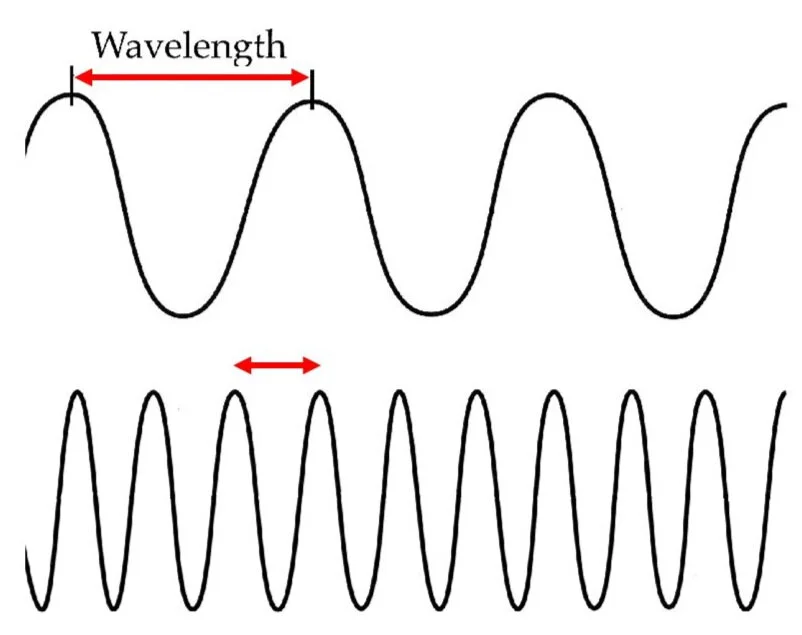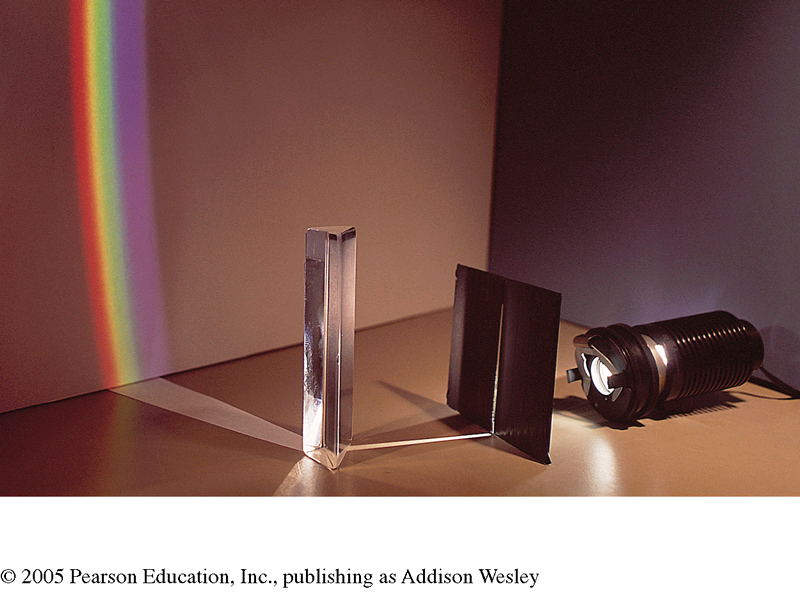What is the relationship between light, wavelength and colour?
Figure 1. Wavelength is defined as the distance (measured in meters, or fractions of a meter) from one peak to the next in a wave. The wave on the top has a longer wavelength than the wave on the bottom.
Light is a natural phenomenon, generated by objects like the Sun, lightbulbs and computer screens. In physics, light is described as having both particle-like and wave-like behaviours and characteristics. Particles of light, called photons, can have a range of energies. As a wave, light has a range of wavelengths or frequencies. The distance between one peak and the next is defined as the wavelength (see Figure 1). Since wavelength is a distance, it is measured in meters (or fractions of a meter). Frequency and energy are related to wavelength via simple mathematical equations. ‘White light’ contains a mixture of waves of high intensity and a range of wavelengths which activate our visual system resulting in the perception of white (or a ‘white-ish’ colour).
When a ray of white light passes through a prism, it is transformed into a spectrum. We can see the coloured spectrum when it reflects from a surface in Figure 2.
Figure 2. A white light source entering the triangular prism from the right, and exiting on the left. We see the coloured spectrum when it reflects from the white wall.
The light that we see with our eyes makes up one small part of the spectrum of electromagnetic radiation (often called the electromagnetic spectrum). It is referred to as visible light by physicists and astronomers, as unlike the other forms of radiation, it is capable of stimulating the human visual system in such a way as to enable vision. There are also parts of the electromagnetic spectrum which are invisible to our eyes: ultraviolet rays, X-rays, gamma rays, microwaves and radio waves. We experience many of these electromagnetic waves in our everyday lives, but we are not able to detect their wavelengths with our eyes. Figure 3 depicts all parts of the electromagnetic spectrum.
Figure 3. Comparison of wavelength, frequency and energy for the electromagnetic spectrum. (Credit: NASA’s Imagine the Universe).
Figure 4. Relative relation of short, middle-length and long wavelengths in the visible spectrum.
The regions of the spectrum are frequently referred to by their relative wavelength relationships: long, middle, and short (see Figure 4). The colours seen in the visible spectrum are vivid in character, and are also seen in the rainbow (in the same order).
These spectral colours are often incorrectly considered as being equivalent to the various wavelengths contained within white light. Light is a physical phenomenon, and its wavelengths can be physically measured with scientific instruments. Colour, on the other hand, is a perceptual phenomenon, resulting from the way our visual system interprets light.
Sometimes you may come across terms like ‘red light’ or ‘blue light’. Phrases like this can lead to the misconception that light rays actually have these colours. It is important to remember that a light contains a range of wavelengths or energies, and it is the response of the human visual system to this range of wavelengths that gives us the sensation or perception of specific colours. However, we may find when teaching or speaking about colour, this type of terminology, although not strictly correct, is helpful for communicating ideas about colour in an understandable manner.
Check out this NASA video and reference for a description of the electromagnetic spectrum.










